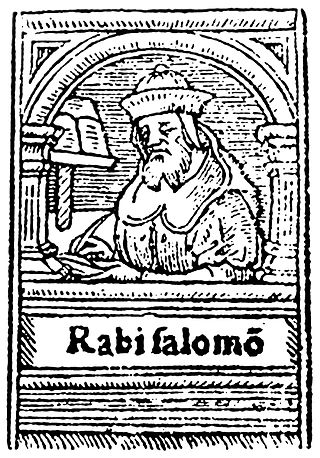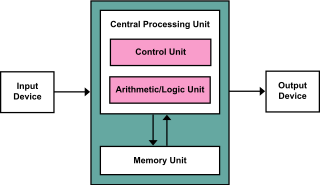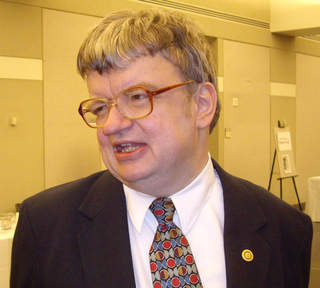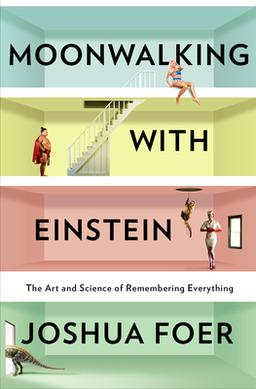Related Research Articles

Shlomo Yitzchaki, generally known by the acronym Rashi, was a medieval French rabbi, the author of comprehensive commentaries on the Talmud and Hebrew Bible.

ENIAC was the first programmable, electronic, general-purpose digital computer, completed in 1945. Other computers had some of these features, but ENIAC was the first to have them all. It was Turing-complete and able to solve "a large class of numerical problems" through reprogramming.

John Adam Presper Eckert Jr. was an American electrical engineer and computer pioneer. With John Mauchly, he designed the first general-purpose electronic digital computer (ENIAC), presented the first course in computing topics, founded the Eckert–Mauchly Computer Corporation, and designed the first commercial computer in the U.S., the UNIVAC, which incorporated Eckert's invention of the mercury delay-line memory.
Memorization is the process of committing something to memory. It is a mental process undertaken in order to store in memory for later recall visual, auditory, or tactical information.

The von Neumann architecture—also known as the von Neumann model or Princeton architecture—is a computer architecture based on a 1945 description by John von Neumann, and by others, in the First Draft of a Report on the EDVAC. The document describes a design architecture for an electronic digital computer with these components:

Laurence Kim Peek was an American savant. Known as a "megasavant", he had an exceptional memory, but he also experienced social difficulties, possibly resulting from a developmental disability related to congenital brain abnormalities. He was the inspiration for the character Raymond Babbitt in the 1988 movie Rain Man. Although Peek was previously diagnosed with autism, he is now thought to have had FG syndrome. The Utah Film Center's Peek Award honors his legacy.

Herman Heine Goldstine was a mathematician and computer scientist, who worked as the director of the IAS machine at the Institute for Advanced Study and helped to develop ENIAC, the first of the modern electronic digital computers. He subsequently worked for many years at IBM as an IBM Fellow, the company's most prestigious technical position.
The First Draft of a Report on the EDVAC is an incomplete 101-page document written by John von Neumann and distributed on June 30, 1945 by Herman Goldstine, security officer on the classified ENIAC project. It contains the first published description of the logical design of a computer using the stored-program concept, which has come to be known as the von Neumann architecture; the name has become controversial due to von Neumann's failure to name other contributors.
The title mnemonist refers to an individual with the ability to remember and recall unusually long lists of data, such as unfamiliar names, lists of numbers, entries in books, etc. Some mnemonists also memorize texts such as long poems, speeches, or even entire books of fiction or non-fiction. The term is derived from the term mnemonic, which refers to a strategy to support remembering, but not all mnemonists report using mnemonics. Mnemonists may have superior innate ability to recall or remember, in addition to relying on techniques.
"Funes the Memorious" is a fantasy short story by Argentine writer Jorge Luis Borges (1899–1986). First published in La Nación of June 1942, it appeared in the 1944 anthology Ficciones, part two (Artifices). The first English translation appeared in 1954 in Avon Modern Writing No. 2.
Akira Haraguchi, is a retired Japanese engineer known for memorizing and reciting digits of pi.
Hyperthymesia, also known as hyperthymestic syndrome or highly superior autobiographical memory (HSAM), is a condition that leads people to be able to remember an abnormally large number of their life experiences in vivid detail. It is extraordinarily rare, with only 62 people in the world having been diagnosed with the condition as of 2021. One who has hyperthymesia is called a hyperthymesiac.
The Ogaden is one of the major Somali clans.
Charmadas was a Greek Academic Skeptic philosopher and a disciple of Carneades at the Academy in Athens. He was famous for his elegant style. Charmadas introduced the teaching of rhetoric into the Academy and is said to have had many students. He was a pupil of Carneades for seven years and later he led his own school in the Ptolemaion, a gymnasium in Athens. He was from Alexandria and seems to have lived there, before he went to Athens around 145 BC He was an excellent rhetorician and famous for his outstanding memory and for his ability to memorize whole books and then recite them. Like Philo of Larissa he seems to have pursued a more moderate philosophical scepticism. Lucius Licinius Crassus and Marcus Antonius (orator) were his most prominent pupils. Furthermore, Philodemus preserved us the names of other pupils: Diodorus of Adramyttion, Apollodor of Tarsus, Heliodorus of Mallos, Phanostratus of Tralles and a certain Apollonius.

Shas Pollak were Jewish mnemonists who, according to the 1917 report of George Stratton in the Psychological Review, memorized the exact layout of words in more than 5,000 pages of the 12 books of the standard edition of the Babylonian Talmud. Stratton's report consists of accounts of and comments on testimonials of three eyewitnesses. Two of the eyewitnesses stated that the memorizing was related to the Talmud part, printed in the centers of the pages, and not the surrounding commentary.
Exceptional memory is the ability to have accurate and detailed recall in a variety of ways, including hyperthymesia, eidetic memory, synesthesia, and emotional memory. Exceptional memory is also prevalent in those with savant syndrome and mnemonists.
Eidetic memory, also known as photographic memory and total recall, is the ability to recall an image from memory with high precision—at least for a brief period of time—after seeing it only once and without using a mnemonic device.

Moonwalking with Einstein: The Art and Science of Remembering Everything is a nonfiction book by Joshua Foer, first published in 2011. Moonwalking with Einstein debuted at number 3 on the New York Times bestseller list and stayed on the list for 8 weeks.
Winnie Bamara was the first Indigenous Australian woman artist to paint in a European realist style. Her ability to paint scenes accurately and solely from memory attracted wide attention in the 1950s. She was hailed as a "female Albert Namatjira".
Huseen Dhiqle, also spelled Xuseen Dhiqle was the memorizer of the orations and poems of the Sayid, as well as his successor at the 1921 Darawiish community at Iimey. Huseen Dhiqle had an eidetic memory whereby he could memorize and recite upwards of 100 of the Sayid's poems upon hearing it once. African studies professor John William Johnson stated that Dhiqle's replacement of the Sayid after his death at Iimey was for a short period of time:
One of the Sayid ' s assistants was entrusted with the duty of memorizing Maxamed Cabdille's poetry during his lifetime
References
- ↑ "Does Photographic Memory Exist?". Scientific American. January 2013. Retrieved 2020-01-05.
- ↑ Foer, Joshua (2006-04-27). "No one has a photographic memory". Slate Magazine. Retrieved 2020-01-05.
- ↑ "eidetic imagery | Definition & Facts". Encyclopedia Britannica. Retrieved 2020-01-05.
- ↑ Wilding, J.M., & Valentine, E.R.: Superior Memory. Hove, England: Psychology Press (1997).
- ↑ "Profile: Hu Jintao". 16 September 2004. Retrieved 4 December 2009.
- ↑ "Hu Jintao: Enigmatic politician who revealed a ruthless streak - Profiles, People - The Independent". Independent.co.uk . 2009-12-20. Archived from the original on 2009-12-20. Retrieved 2024-03-31.
- ↑ "Jimmy Rollins is ready to pick right back up where he left off: with hits". ESPN.com. 2006-02-27. Archived from the original on 2017-12-01. Retrieved 2024-04-02.
- ↑ Woods, Joanna (2008). Facing The Music Charles Baeyertz and The Triad. Otago University Press. ISBN 978-1-877372-55-1., pp. 22–23
- ↑ K. V. Parish, 'The remarkable art of Winnie Bamara', The Sunday Mail, February 14, 1959, p.7
- ↑ "The Information Age". The Nineties. 2017. CNN.
- ↑ Donovan, Karen (2007). V. Goliath: The Trials of David Boies. Knopf Doubleday Publishing Group. p. 81. ISBN 978-0-375-72655-2 . Retrieved 3 September 2017.
- ↑ Abokor, Axmed (1993). Somali Pastoral Work Songs. p. 23.
Huseen - Dhiqle, who had the reputation of memorizing many poems hundreds of lines long after hearing them
- 1 2 Calinger, Ronald S. (2015). Leonhard Euler: Mathematical Genius in the Enlightenment. Princeton University Press. p. 22. ISBN 9780691119274.
- ↑ Sacks, Oliver (1995). An anthropologist on Mars : seven paradoxical tales (1st ed.). New York: Vintage/Picador. p. 198. ISBN 0-679-43785-1.
- ↑ Adams, Lee (1 March 2006). "The Truth About Photographic Memory". psychologytoday.com. Retrieved 16 December 2015.
- ↑ Bellos, Alex (2015-03-13). "He ate all the pi : Japanese man memorises π to 111,700 digits". The Guardian. ISSN 0261-3077 . Retrieved 2020-01-05.
- ↑ Caron, Emily (12 September 2018). "Rams Coach Sean McVay can recall every play he's ever coached". Sports Illustrated. Retrieved 18 February 2024.
- ↑ Lebron
- ↑ lebron2
- ↑ Tremper, Will (1 January 1993). Meine wilden Jahre. Ullstein. p. 234. ISBN 978-3-550-06046-5 . Retrieved 18 February 2017.
- ↑ Xavier, Ramnik J.; Virgin, Herbert W. (6 August 2020). "Beth Levine (1960–2020)" (PDF). Cell. 182 (3): 533–536. doi:10.1016/j.cell.2020.07.002.
- ↑ Paul Tankard, “William Empson on C.S. Lewis’s Memory and Reading,” Notes and Queries, vol. 259, no. 4; N.S. 61:4 (Dec., 2014), 614-16. doi: 10.1093/notesj/gju181
- ↑ pnd (2011-07-15). Ādi 16: The Pastimes of the Lord in His Childhood and Youth.
- ↑ Trotter, William R. Priest of Music: The Life of Dimitri Mitropoulos. Portland, Oregon: Amadeus Press, 1995. ISBN 0-931340-81-0.
- ↑ Şükran Vahide. (2005). Islam in Modern Turkey. State University of New York Press, ISBN 0-7914-6515-2
- ↑ Joshua Foer (27 April 2006). "Kaavya Syndrome: No one has a photographic memory". slate.com.
- ↑ "A way with words". Stuff. 2010-06-05. Retrieved 2022-01-27.
- ↑ Neill, Ushma S. (2019-08-01). "A conversation with Lucy Shapiro". The Journal of Clinical Investigation. 129 (8): 2981–2982. doi:10.1172/JCI131492. ISSN 0021-9738. PMC 6668687 . PMID 31368904.
- ↑ "Nigeria's Boko Haram leader Abubakar Shekau in profile". BBC News. 9 May 2014. Archived from the original on 2015-06-05. Retrieved 2024-04-06.
- ↑ Ludwig M., Arnold (2004). King of the Mountain: The Nature of Political Leadership. University Press of Kentucky. p. 150.
- ↑ Borowski, Susan (29 May 2012). "The brilliant and tortured world of Nikola Tesla". American Association for the Advancement of Science (AAAS) MemberCentral. Retrieved 16 December 2015.
- ↑ "Arturo Tosanini". bpbclassics.demon.co.uk. Retrieved 2017-02-06.
- ↑ "Toscanini: A Brief Biography" Archived 2017-07-28 at the Wayback Machine . arturotoscanini.org. Retrieved 2017-02-06.
- ↑ M. Rajamanickam (1 January 2007). Modern General Psychology, Second Edition (revised And Expanded) (in 2 Vols.). Concept Publishing Company. p. 434. ISBN 978-81-8069-421-9.
- ↑ Rangachari, Devika (1 January 2011). Swami Vivekananda: A Man with a Vision. Penguin Books Limited. p. 21. ISBN 978-81-8475-563-3 . Retrieved 14 January 2016.
- ↑ Halmos, Paul (April 1973). "The Legend of von Neumann". American Mathematical Monthly . 80 (4): 382–394. doi:10.2307/2319080. JSTOR 2319080.
- ↑ The Computer from Pascal to von Neumann, by Herman Goldstine, 1972, Princeton Univ. Press, ISBN 0-691-08104-2, p. 167
- ↑ Treffert, Darold (1989). Extraordinary People: understanding "idiot savants". New York: Harper & Row. ISBN 0-06-015945-6.
- ↑ David Martin. Savants: Charting "islands of genius", CNN broadcast September 14, 2006